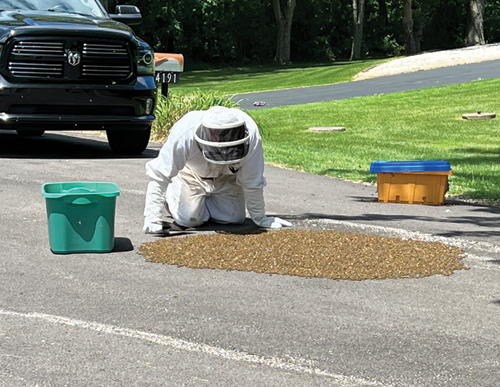EMT rescues queen and bee swarm
by Wendy Turrell
When Village of Richfield Landscape Supervisor Walt Dorsey took a call about a bees’ nest that had fallen onto Buell Drive, he was afraid he might have to deal with a hornets’ nest. But when he got there he said he noticed there was no nest at all, just thousands of bees huddled on the road.
Thinking they might be endangered honeybees, he called Richfield naturalist Ellen Daniels, who was able to quickly identify them as such from photos he sent. Hoping to save this colony, the two contacted beekeeper Greg Bokan. He was on vacation, but he directed them to Richfield Emergency Medical Technician Kevin Urban, who is an amateur beekeeper.
Urban said when he arrived at Buell Drive he found two piles of bees. “One was in the grass and one in the street. I thought there must be two different swarms and two different queens,” he said.
Urban explained that bees follow their queen by scenting a pheromone she releases. His goal was to locate the queen and safely place her in a container. “Then all the other bees from her swarm would follow,” he said.
“I had quickly located a queen in the small pile about a foot in diameter on the grass, and placed her in a bee box. The larger collection of bees in the street was maybe five feet in diameter and contained three or four layers of bees,” he said.
He found it difficult to locate a queen in the larger pile, so he scooped up those bees and put them into a second container and took them to his hives.
“I placed each group of bees into a new hive, but after about an hour, the street bees all migrated into the hive with the grass bees. That led me to believe there was only one queen for both clumps of bees, and they just found their way back to her.”
Dorsey kept his distance during the retrieval, and directed traffic and blocked the road with the Richfield Village service truck.
“It was very helpful having Walt … control vehicle and pedestrian traffic for my safety and the safety of others. Honey bees are generally very gentle creatures, but sometimes they can be unpredictable when they have been displaced,” said Urban.
For his part, Dorsey said, “It really was an extraordinary experience watching him as he went about the task at hand, as well as knowing it gave these honey bees a fighting chance at surviving.”
Bees pollinate about 30% of the world’s food crops and 90% of the wild plants, according to Urban. He has been keeping bees for about four years, a hobby he began because he wanted to help local pollinators. He has four hives – counting the newest one he collected on Buell Drive – and said it takes about an hour and a half weekly to inspect and maintain his hives.
“I find it very challenging, yet therapeutic,” he said.
Urban advised anyone who finds a swarm on their property to contact the Summit County Beekeepers Association to collect and relocate them. “It is best to keep your distance from them, just in case they are a little uneasy from the move.”
More information is available at summitbeekeepers.com/swarms.
Chemicals and diseases increasingly threaten bees. Urban said the best way to protect them is to stop using herbicides and pesticides. He said the chemicals that make lawns green and uniform also kill the flowering clover and dandelions which bees need.
Urban urged homeowners to plant bee-friendly flowers like daisies, sunflowers and black-eyed Susans, and flowers in purple, blue, white and yellow colors that bees like. ∞

Main Photo (above): Kevin Urban looked for the queen bee and then scraped up the bees and put them in a container. Photos by E. Daniels.

